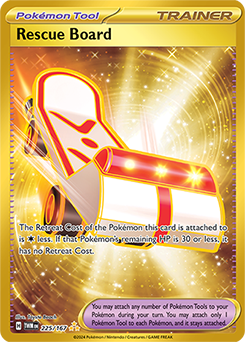Allergy Season — Deck Building in Budew’s World
Hey everyone! It’s Charlie and I’m happy to be back with another article. In my last article, I went over Raging Bolt ex , which is the deck I took to Atlanta Regionals. I finished 72nd, bubbling out of Top 64 with a record of 9-3-1. My losses were to a late penalty for missing Round 1 (a first in my 14-year career), a Gholdengo ex / Dudunsparce deck, and Brent Tonisson’s Gardevoir ex deck. Gardevoir is simply a bad matchup for Raging Bolt as Lillie’s Clefairy ex makes quick work of all your Raging Bolt, but Gholdengo is certainly a close one. I faced a whopping six Gholdengo ex decks during the tournament, and took down the other five, so I can’t be unhappy losing to one, especially when it’s piloted by Connor Finton. Other than that, I tied a Dragapult ex deck in the last round, which is a favorable matchup, but certainly very loseable. My other wins came against Dragapult, Ceruledge ex , a Terapagos ex / Charizard ex deck, and something else that I forget.
Overall, I feel that Raging Bolt was an alright play for the event. I knew that there would be good players piloting Gardevoir ex , but for a tournament with over 2,700 Masters, I didn’t expect there to be enough to have to worry about. I only hit one, which was about what I expected, so I think my prediction was fine. The thing that really killed my event was that Round 1 loss because of being late, but the entire event would’ve been different if I won, so I can’t linger on it for too long. 9-3-1 is still acceptable and pushes me nearly to 700 Championship Points, which should be enough to lock the invite.
Budew’s Dominance in Atlanta

Enough of that though, let’s get into today’s topic! The biggest topic of conversation after Atlanta has been the impact of Budew. This little, unassuming, 30-HP baby has been wreaking havoc on the game ever since its release. For zero Energy, Itchy Pollen can Item-lock your opponent! That’s a truly absurd attack, and even though it only does 10 damage, the cost being zero Energy means it’s extremely easy to use on your first turn going second. As long as you can get it into the Active Spot (should be easy between Arven for Rescue Board and the Energy in your deck), you can immediately start the Item lock and use it to get ahead.
A whopping seven of the eight decks in Top 8 featured a copy of Budew in them, with the finals serving as a perfect metaphor for the state of the format. We saw Andrew Hedrick and Henry Chao exchange Itchy Pollen for 75 minutes plus three turns, with Henry eventually coming out on top after a very lucky Professor's Research into the game-winning combo. Regardless of what decks it fits best in, we haven’t seen dominance like this in a while from a single card. Of the Top 32 finishers, 18 included Budew in their deck, mostly with the goal to slow down the game in order to set up a nearly invincible board. Dragapult does this by using an army of Drakloak to draw a ton of cards, and it takes each additional turn it scores from Budew to attach another Energy, ensuring Dragapult can attack for multiple consecutive turns once you break the Item lock. Dragapult’s main weakness was always speed, and Budew patches it perfectly. Gardevoir employs a similar strategy, making up for its lack of Refinement Kirlia with either a slew of draw Supporters or a thin line of N’s Zoroark ex to replicate Refinement. This gives you time to get Energy in the discard and set up multiple Munkidori with Darkness Energy, which is extremely hard for basically any other deck to deal with.
Both of those decks would usually be very weak against aggressive strategies that attack their setup in the early game, but Budew covers that weakness so well that both decks dominated Atlanta. I know that multiple top players who played Dragapult ex said their matchup against Raging Bolt felt like a near-autowin. I certainly disagree, but if Raging Bolt blindly gets too aggressive, they will be punished instantly by Unfair Stamp , Counter Catcher , and more Itchy Pollen from Budew. Once their perfect board of Dragapult is set up, it doesn’t really matter what you do, because they’ll be able to set up a game-winning combo with Dusknoir and destroy your entire board. Gardevoir can do very similar things, using their Munkidori to take out small Pokemon and remove Gardevoir’s Psychic Embrace damage, while also attacking for huge damage using Drifloon , Scream Tail , or just Gardevoir itself. These strategies are almost too good not to play if they get set up, and their main weakness is covered so well by a low-cost card that it becomes oppressive.
A whopping 23 (nearly 72%) of decks in Top 32 of Atlanta included Budew. That is a ridiculously high number. I didn’t think I’d see another event similar to Seattle Regionals 2017 in my career, but here we are.
History Lesson: Garbodor GRI
For those of you who weren’t playing then, Guardians Rising was released prior to this infamous event. I’d consider Guardians Rising to be one of the best sets of all time; it introduced cards like Tapu Lele-GX and Field Blower, which were all-time greats by themselves. However, no card was nearly as format-warping as Garbodor. Trashalanche changed the way the game was played, doing 20 damage for each Item card in your opponent’s discard pile. Prior to Guardians Rising, the vast majority of decks relied almost exclusively on powerful Item cards to set up. There were many powerful Items in the game, and effectively no way to punish them. Also, Pokemon-EX were being phased out, which were notoriously all Basic Pokemon. This made the best attackers extremely easy to put into play, incentivizing turbo decks to go all-in on getting ahead. Trashalanche offered a soft check to these turbo decks. Instead of just providing Item lock, which everyone would’ve hated as Seismitoad-EX had recently rotated, Trashalance punished your opponent for choosing to play so many Item cards. Turbo decks could easily put ten to twelve Item cards in the discard pile by turn 2, which turned Garbodor into a menacing single-Prize attacker. Also, one of the most important parts about Garbodor is just that it was Garbodor! Garbodor from BREAKpoint was still legal, and Garbotoxin was as good as ever. Pairing these two Garbodor slowed down the game massively, pushing the vast majority of turbo decks out of the format.
This brings us to Seattle Regionals. 24 decks in the Top 32 featured the new Garbodor, with some based around Drampa-GX and others based around Espeon-GX . Both strategies were very strong, but they had the same game plan: set up slower, but more powerful attackers, use Garbotoxin against Ability-reliant decks, and punish turbo decks with Trashalanche.
I really think that Budew’s surge onto the scene is extremely similar. The best strategies in the game (Dragapult and Gardevoir) are slow, but extremely strong when set up. Budew, just like Garbodor, is an extremely powerful card that counters turbo decks extremely well. With extra time to set up, the best attackers get even better. When you no longer have to trade your time for power, you have a ridiculous advantage. What the designers probably saw as a “comeback” was never really being behind; it was just taking a few turns to get started, with your opponent knowing full well that they were doomed.
Why Now?
Unlike Garbodor, Budew’s rise to dominance wasn’t instant. Budew’s first event in the West was EUIC, where it did very well, but didn’t overwhelm. It was featured in both finalist decks, but it wasn’t the core of their strategy. Its main effect was bringing Dragapult ex out of Regidrago VSTAR decks and into its own archetype, using some of the extra time Budew can buy you in order to set up an attacker with a bit more HP. Regidrago was so much faster, but its weakness to Budew was impossible to ignore. I think the main reason for this is that the “standard” deck engines at the time already had a bit of built-in Budew resistance. With cards like Forest Seal Stone in the format, Arven could still do something of value under Item lock. Decks like Archaludon ex were a little more powerful than they are right now, so Duraludon‘s Hammer In was more likely be there to take out Budew. Gardevoir ex still had access to Refinement Kirlia, so as long as it could Arven for Technical Machine: Evolution and set up a few, it was okay. I personally think this is the effect Budew was intended to have: a nice buff for slower decks, slowing the game down just a tad and checking powerful early-game combo decks. However, a lot of these soft answers to Budew immediately rotated, leaving us with a Standard format that can’t answer the card nearly as well.
This concludes the public portion of this article.
If you'd like to continue reading, consider purchasing a PokeBeach premium membership! If you're not completely satisfied with your membership, you can request a full refund within 30 days.
Each week we post high-quality content from some of the game's top players. Our article program isn't a corporate operation, advertising front, or for-profit business. We set our prices so that we can pay the game's top players to write the best content for our subscribers. Each article topic is carefully selected, goes through multiple drafts, and is touched up by our editors. We take great pride in our program!

